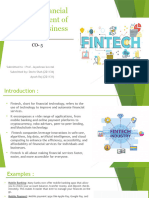FinTech Ecosystem
A FinTech ecosystem refers to the interconnected network of financial technology companies,
institutions, and other stakeholders that work together to innovate and deliver financial services
using digital technologies. This ecosystem includes various components that collaborate,
compete, and evolve to provide modern financial solutions.
Key elements of the FinTech ecosystem include:
1. FinTech Companies: Startups and established firms that develop innovative financial
products and services, such as mobile banking apps, peer-to-peer lending platforms,
cryptocurrency exchanges, digital wallets, and robo-advisors.
2. Financial Institutions: Banks, insurance companies, and asset management firms that
partner with or compete against FinTech companies. Many traditional institutions are
adopting or investing in FinTech solutions to stay competitive.
3. Regulators and Government: Regulatory bodies that establish laws and guidelines to
ensure the security, stability, and compliance of financial systems, while fostering
innovation. Examples include the SEC (Securities and Exchange Commission) and the
Federal Reserve in the U.S.
4. Technology Providers: Companies that supply the technology infrastructure needed for
FinTech solutions, such as cloud computing services, cybersecurity firms, and data
analytics platforms.
5. Investors: Venture capitalists, private equity firms, and angel investors that fund FinTech
startups and projects, enabling innovation and growth within the ecosystem.
6. Consumers: Individuals and businesses that use FinTech products and services for more
convenient, faster, and cost-effective financial transactions.
7. Incubators and Accelerators: Organizations that help early-stage FinTech startups
develop their ideas, providing mentorship, resources, and access to funding.
The FinTech ecosystem thrives on collaboration, technology, and innovation, driving the
transformation of traditional financial systems into more accessible, efficient, and user-centric
�models. Key areas of focus include mobile payments, blockchain, artificial intelligence (AI), and
open banking.
�Short History of Fintech
It is hard to pinpoint when financial technology began, but the 1950s are a good reference point.
Technology is a key component of the financial services sector in various ways.
The 1950s saw the introduction of credit cards. Instead of carrying cash, people used
these cards to pay for their purchases.
ATMs were introduced in the 1960s, meaning that people no longer had to visit bank
branches for certain transactions.
In the 1970s, firms began to trade stocks electronically.
In the 1980s, banks started using mainframe computers and other state-of-the-art
recordkeeping and data systems.
In the 1990s, ecommerce business models and the Internet thrived. Because of this, retail
investors could experiment with online stock trading.
During the 50 years of fintech developments, innovators have created sophisticated
treasury management, risk management, data analysis tools, and trade processing for
financial services firms and institutional banks.
Currently, fintech is digitising retail financial services through crowdfunding platforms, Robo-
advisors for retirement and wealth planning, payment apps, mobile wallets, and the like. Fintech
provides access to alternative and private investment opportunities, as well as online lending
platforms.
However, despite the fact that fintech is flourishing, banks have not been greatly affected. The
main reason for this is that fintech and banks complement each other. Banks have realised that
technology is a strategic asset and that it needs to be taken seriously.
�Why has Fintech Become Popular Now?
The fintech sector received a huge influx of funds in 2014. The startups that received funding are
hungry and ambitious and want to disrupt the banking sector. There are several factors that have
contributed to the fact that fintech is flourishing now.
One of these is that fintech promises healthy returns on investments and growth opportunities,
even though the business models are not yet fully understood. For example, nobody knows
whether peer-to-peer financing is a model that can be sustained in the long term.
Additionally, new technologies have been emerging in several industries that can also be applied
to financial services. These include blockchain technology, advanced machine learning software,
micro-sized card readers and chips, and powerful servers capable of performing intelligent
analytics. Social networks and micro marketing have also broken down the barriers to entering
the industry, as some fintechs can achieve very low acquisition costs, as little as 1% of the
costs of national and community banks.
Customer expectations also drive this increased interest in the industry. Previous generations
failed to experience a respect-based, personalised, and one-to-one relationship with their bank.
However, millennials demand it. With advanced personalisation and Internet technologies, they
can access the kind of banking relationships that they have come to expect. The use of data
provides the potential for financial services companies to know and treat their customers
better.
Finally, regulation changes have also helped fintech. Generally, regulations can hinder influx of
capital and growth. They can slow things down because they are there to protect and control the
public. However, many regulators have recognised the value of technology and have provided
innovation sandboxes or flexed the rules for small players. The lack of regulation for some
segments, such as peer-to-peer lending, has helped new companies grow at a fast pace.























































































